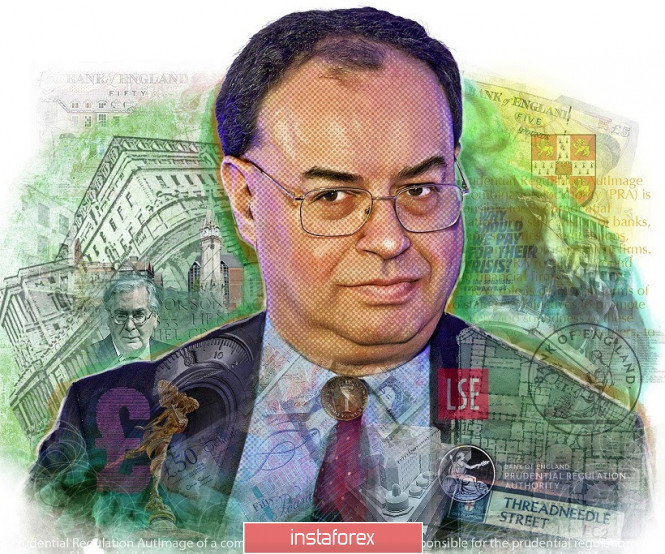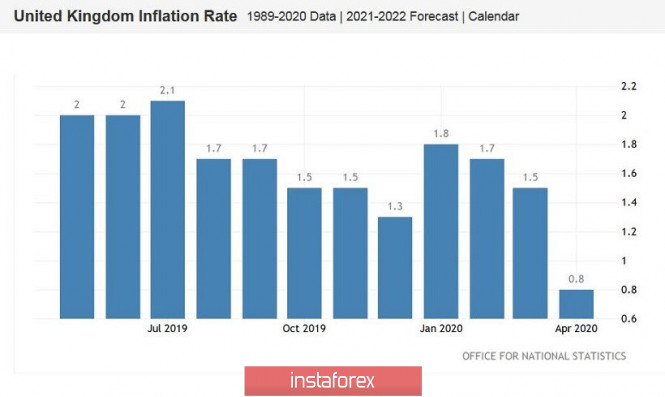The pound-dollar pair retreated from two-month price lows due to the general wave of optimism associated with the possible creation of a fund to restore the European economy. By and large, the pound followed the euro, while its own fundamental factors are only negative for the British currency. The single currency suspended its growth during the Asian session on Thursday, after which the GBP/USD pair turned down similarly, returning to the 21st figure. The latest inflation data, and in particular the subsequent comments by Bank of England Governor Andrew Bailey, put significant pressure on the pound, so the resumption of the downward trend was only a matter of time. Looking ahead, we can say that long positions on the pair will be extremely risky until the English regulator abandons its intentions to lower the interest rate in the negative area. To date, this issue is still a matter of discussion, which means the pound is still vulnerable.

It should be noted that the BoE governor has significantly softened his rhetoric in three months. For example, in early March, Bailey actually ruled out the option of reducing the rate "under zero" – in his opinion, negative interest rates will have a negative impact on the UK banking sector. But in early May, he surprised the markets with his dovish attitude. First, he allowed the expansion of incentives – according to him, the central bank will make a decision on expanding QE in June, when the epidemiological picture and the extent of restrictive measures will be clear. Secondly, he said that the regulator has not yet used the arsenal of monetary policy tools – "all options remain open." Third, Bailey was less clear about the likelihood of a negative rate. According to him, "there is no question of negative rates in the near future." Although in this case it was about subtle changes in verbal wording, traders paid attention to this nuance, anticipating a further softening of the rhetoric.
And they were not mistaken – this week the BoE governor has already openly stated that the central bank is "actively considering the option of introducing a negative rate." He added that economists are now studying the similar experience of other central banks, not ruling out that this scenario can be implemented in the UK. This rhetoric was voiced by Bailey at a parliamentary hearing on the BoE's report on the prospects for monetary policy. He first spoke in the British Parliament as the head of the English regulator, and probably for this reason decided to "go with the trumps", demonstrating his determination in the fight against the consequences of the coronavirus crisis.
It is also worth noting that the parliamentary hearings were held after the publication of disappointing inflation data, so such dovish rhetoric may be due to this factor. Yesterday's release of data on the growth of British inflation really turned out to be a failure. Almost all components came out in the red zone, significantly falling short of the forecast values. For example, the overall consumer price index in April fell to -0.2% on a monthly basis. There is also a downward trend in annual terms: the indicator fell to 0.8% - the weakest growth rate in many years. Core inflation also disappointed – the core consumer price index came out at 1.4%, that is, at a three-year low. The retail price index also showed a weak result, both in annual and monthly terms. The index of purchasing prices of producers was also in the red zone, as it fell by almost ten percent in April – this is another anti-record.
It is worth noting that inflationary data only supplemented the negative fundamental picture. Key macroeconomic reports have recently been disappointing, perhaps without any exceptions. According to the forecasts of the English regulator, according to the results of the current year, the volume of GDP will decrease by almost 15% - according to economists of the central bank, this is the most significant economic slowdown since 1709, that is, over the past 311 years (Britain was then plagued by natural disasters and war). Moreover, according to the central bank, large-scale programs to stimulate the economy will not restrain the downward trend of key macroeconomic indicators.

Such a fundamental picture looks like a springboard for bears. But here it should be noted that the pair simultaneously retains the potential for its upward rebound. The fact is that Bailey's statement about introducing a negative rate is more political than practical in nature, given where and under what circumstances this statement was made. In addition, as you know, the BoE governor does not have the power to solely lower or raise the rate. And if other members of the Committee oppose this idea, the pound can quickly regain its position. But until this happens, the pair will be dominated by bears.
From a technical point of view, the upward dynamics of the pair is also a priority. The price is under the Kumo cloud on the daily chart, under all the lines of the Ichimoku indicator and between the middle and lower lines of the Bollinger Bands trend indicator. All this suggests that from current positions you can consider selling to the nearest support level of 1.2100 - this is the lower line of Bollinger Bands on the same timeframe.
The material has been provided by InstaForex Company - www.instaforex.com